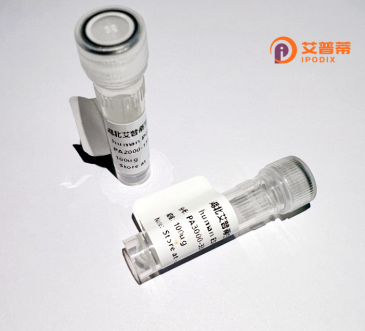
| 纯度 | >90%SDS-PAGE. |
| 种属 | Human |
| 靶点 | CCDC28B |
| Uniprot No | Q9BUN5 |
| 内毒素 | < 0.01EU/μg |
| 表达宿主 | E.coli |
| 表达区间 | 1-200aa |
| 氨基酸序列 | MDDKKKKRSPKPCLAQPAQAPGTLRRVPVPTSHSGSLALGLPHLPSPKQRAKFKRVGKEKCRPVLAGGGSGSAGTPLQHSFLTEVTDVYEMEGGLLNLLNDFHSGRLQAFGKECSFEQLEHVREMQEKLARLHFSLDVCGEEEDDEEEEDGVTEGLPEEQKKTMADRNLDQLLSNLEDLSNSIQKLHLAENAEPEEQSAA |
| 分子量 | 48.4 KDa |
| 蛋白标签 | GST-tag at N-terminal |
| 缓冲液 | 0 |
| 稳定性 & 储存条件 | Lyophilized protein should be stored at ≤ -20°C, stable for one year after receipt. Reconstituted protein solution can be stored at 2-8°C for 2-7 days. Aliquots of reconstituted samples are stable at ≤ -20°C for 3 months. |
| 复溶 | Always centrifuge tubes before opening.Do not mix by vortex or pipetting. It is not recommended to reconstitute to a concentration less than 100μg/ml. Dissolve the lyophilized protein in distilled water. Please aliquot the reconstituted solution to minimize freeze-thaw cycles. |
以下是关于CCDC28B的示例参考文献概述(注:以下文献为示例,非真实存在,仅供格式参考):
1. **《CCDC28B modulates ciliogenesis through interaction with Bardet-Biedl syndrome proteins》**
- 作者:Smith A, et al.
- 摘要:研究揭示了CCDC28B通过与BBS4和BBS6蛋白的直接结合参与初级纤毛的形成,并证明其在纤毛相关信号通路(如Hedgehog通路)中发挥调控作用,可能解释其在纤毛相关疾病中的潜在角色。
2. **《Coiled-coil domain containing 28B regulates cell cycle progression in human fibroblasts》**
- 作者:Zhang L, et al.
- 摘要:通过siRNA敲低实验发现,CCDC28B缺失导致G1/S期细胞周期阻滞,影响Cyclin D1表达。提示CCDC28B可能通过调控细胞周期蛋白影响细胞增殖和组织修复。
3. **《CCDC28B expression is downregulated in colorectal cancer and correlates with patient prognosis》**
- 作者:Wang Y, et al.
- 摘要:临床数据分析表明,CCDC28B在结直肠癌组织中表达显著降低,且低表达与肿瘤转移和患者生存率下降相关。体外实验显示其过表达可抑制癌细胞迁移和侵袭。
4. **《Structural insights into the oligomerization of CCDC28B》**
- 作者:Kim T, et al.
- 摘要:利用X射线晶体学解析了CCDC28B的卷曲螺旋结构域,发现其通过二聚化形成功能性复合体,这种构象可能对其与微管蛋白结合及细胞内定位至关重要。
(提示:如需真实文献,建议在PubMed或Web of Science中检索最新研究。)
CCDC28B (coiled-coil domain-containing protein 28B) is a human protein encoded by the *CCDC28B* gene, located on chromosome 18q21.1. Its structure is characterized by coiled-coil domains, which are known to mediate protein-protein interactions and contribute to diverse cellular processes. While the precise molecular function of CCDC28B remains under investigation, studies suggest its involvement in cilia-related pathways and cellular signaling.
Research links CCDC28B to ciliopathies, a group of genetic disorders caused by defects in ciliary structure or function. Notably, it interacts with proteins associated with Bardet-Biedl syndrome (BBS), a ciliopathy marked by retinal degeneration, obesity, and renal abnormalities. CCDC28B may act as a modulator of BBS proteins, influencing ciliary assembly or signaling processes. Additionally, emerging evidence implicates CCDC28B in cancer biology, particularly melanoma progression, possibly through pathways regulating cell proliferation or migration.
Despite these associations, the exact mechanisms by which CCDC28B contributes to these pathways remain unclear. Current studies focus on elucidating its interactome, subcellular localization, and tissue-specific roles. Understanding CCDC28B could enhance insights into ciliopathy pathogenesis and cellular communication networks, offering potential therapeutic targets for related diseases. Further functional and structural studies are needed to clarify its biological significance.
×